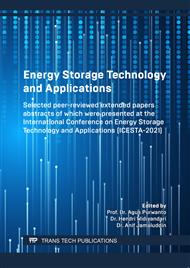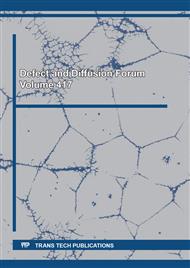[1]
S. Silviana, R.M. Hasbi, C.P. Sagita, O.D. Nurhayati, A. Fauzan, J.U.D. Hatmoko, Silika alam dari limbah padatan pengeboran geotermal di dieng sebagai silika gel melalui proses ramah lingkungan, Natural silica of solid waste from geothermal drilling in dieng as silica gel through environmentally benign processing, Prodising Seminar Nasional Teknologi Hijau. 2 (2017) 341-346.
Google Scholar
[2]
H. Chu, Q. Wu, J. Huang, Rice husk derived silicon/carbon and silica/carbon nanocomposites as anodic materials for lithium-ion batteries, Colloids and Surfaces A: Physicochemical and Engineering Aspects. 558 (2018) 495–503.
DOI: 10.1016/j.colsurfa.2018.09.020
Google Scholar
[3]
Y. Jiang, Y. Zhang, X. Yan, M. Tian, W. Xiao, H. Tang, A sustainable route from fly ash to silicon nanorods for high performance lithium ion batteries, Chemical Engineering Journal. 330 (2017) 1052–1059.
DOI: 10.1016/j.cej.2017.08.061
Google Scholar
[4]
S. Silviana, W.J. Bayu, Silicon Conversion from Bamboo Leaf Silica by Magnesiothermic Reduction for Development of Li-ion Baterry Anode, in: MATEC Web of Conferences, EDP Sciences, 156 (2018) 1-4.
DOI: 10.1051/matecconf/201815605021
Google Scholar
[5]
S. Silviana, G. Jethro Sanyoto, A. Darmawan, Preparation of geothermal silica glass coating film through multi-factor optimization, Jurnal Teknologi. 83 (2021) 41–49.
DOI: 10.11113/jurnalteknologi.v83.16377
Google Scholar
[6]
S. Silviana, G.J. Sanyoto, A. Darmawan, H. Sutanto, Geothermal silica waste as sustainable amorphous silica source for the synthesis of silica xerogels, Rasayan Journal of Chemistry. 13 (2020) 1692–1700.
DOI: 10.31788/rjc.2020.1335701
Google Scholar
[7]
S. Silviana, A. Darmawan, F. Dalanta, A. Subagio, F. Hermawan, H.M. Santoso, Superhydrophobic coating derived from geothermal silica to enhance material durability of bamboo using hexadimethylsilazane (HMDS) and trimethylchlorosilane (TMCS), Materials. 14 (2021) 1–20.
DOI: 10.3390/ma14030530
Google Scholar
[8]
S. Silviana, A. Darmawan, A. Subagio, F. Dalanta, Statistical approaching for superhydrophobic coating preparation using silica derived from geothermal solid waste, ASEAN Journal of Chemical Engineering. 19 (2019) 91–99.
DOI: 10.22146/ajche.51178
Google Scholar
[9]
A. Purnomo, F. Dalanta, A.D. Oktaviani, S. Silviana, Superhydrophobic coatings and self-cleaning through the use of geothermal scaling silica in improvement of material resistance, in: AIP Conference Proceedings, American Institute of Physics Inc., 2026 (2018) 020077.
DOI: 10.1063/1.5065037
Google Scholar
[10]
S. Silviana, F. Dalanta, G.J. Sanyoto, Utilization of bamboo leaf silica as a superhydrophobic coating using trimethylchlorosilane as a surface modification agent, in: Journal of Physics: Conference Series, IOP Publishing Ltd, 1943 (2021) 012180.
DOI: 10.1088/1742-6596/1943/1/012180
Google Scholar
[11]
S. Silviana, B. Jos, H. Santosaa, S. Sumardiono, Statistical Approach for Water Glass Precursor Preparation from Bamboo Leaf Silica, Jurnal Kimia Sains Dan Aplikasi. 22 (2019) 52–57.
DOI: 10.14710/jksa.22.2.52-57
Google Scholar
[12]
S. Silviana, I.N.H. Rambe, H. Sudrajat, M.A. Zidan, Statistical approaching of sol-gel process in preparation of silica aerogel derived from geothermal silica by several acids, in: AIP Conference Proceedings, American Institute of Physics Inc., 2022 (2019) 020069.
DOI: 10.1063/1.5141682
Google Scholar
[13]
M.L.N. Perdigoto, R.C. Martins, N. Rocha, M.J. Quina, L. Gando-Ferreira, R. Patrício, L. Durães, Application of hydrophobic silica-based aerogels and xerogels for removal of toxic organic compounds from aqueous solutions, Journal of Colloid and Interface Science. 380 (2012) 134–140.
DOI: 10.1016/j.jcis.2012.04.062
Google Scholar
[14]
S. Silviana, D.D. Anggoro, C.A. Salsabila, K. Aprilio, Utilization of geothermal waste as a silica adsorbent for biodiesel purification, Korean Journal of Chemical Engineering. 38(10) (2021) 2091-2105.
DOI: 10.1007/s11814-021-0827-z
Google Scholar
[15]
J.A. Lee, M.K. Kim, J.H. Song, M.R. Jo, J. Yu, K.M. Kim, Y.R. Kim, J.M. Oh, S.J. Choi, Biokinetics of food additive silica nanoparticles and their interactions with food components, Colloids and Surfaces B: Biointerfaces. 150 (2017) 384–392.
DOI: 10.1016/j.colsurfb.2016.11.001
Google Scholar
[16]
S. Silviana, A. Darmawan, A.A. Janitra, A. Ma'ruf, I. Triesty, Synthesized silica mesoporous from silica geothermal assisted with CTAB and modified by APTMS, International Journal of Emerging Trends in Engineering Research. 8 (2020) 4854–4860.
DOI: 10.30534/ijeter/2020/125882020
Google Scholar
[17]
S. Silviana, E.A.P.P. Sagala, S.E. Sari, C.T.M. Siagian, Preparation of mesoporous silica derived from geothermal silica as precursor with a surfactant of cethyltrimethylammonium bromide, in: AIP Conference Proceedings, American Institute of Physics Inc., 2022 (2019) 020070.
DOI: 10.1063/1.5141683
Google Scholar
[18]
S. Silviana, A. Purbasari, A. Siregar, A.F. Rochyati, T. Papra, Synthesis of mesoporous silica derived from geothermal waste with cetyl trimethyl ammonium bromide (CTAB) surfactant as drug delivery carrier, in: AIP Conference Proceedings, American Institute of Physics Inc., 2296 (2020) 020083.
DOI: 10.1063/5.0030487
Google Scholar
[19]
M. Frías, H. Savastano, E. Villar, M.I. Sánchez De Rojas, S. Santos, Characterization and properties of blended cement matrices containing activated bamboo leaf wastes, Cement and Concrete Composites. 34 (2012) 1019–1023.
DOI: 10.1016/j.cemconcomp.2012.05.005
Google Scholar
[20]
S. Silviana, A. Noorpasha, M.M. Rahman, Preliminary study of chitosan coating silica derived from geotermal solid waste, Civil Engineering and Architecture. 8 (2020) 281–288.
DOI: 10.13189/cea.2020.080311
Google Scholar
[21]
H. Setyawan, M. Yuwana, R. Balgis, PEG-templated mesoporous silicas using silicate precursor and their applications in desiccant dehumidification cooling systems, Microporous and Mesoporous Materials. 218 (2015) 95–100.
DOI: 10.1016/j.micromeso.2015.07.009
Google Scholar
[22]
N. Lin, Y. Han, J. Zhou, K. Zhang, T. Xu, Y. Zhu, Y. Qian, A low temperature molten salt process for aluminothermic reduction of silicon oxides to crystalline Si for Li-ion batteries, Energy and Environmental Science. 8 (2015) 3187–3191.
DOI: 10.1039/c5ee02487k
Google Scholar
[23]
M. Barati, S. Sarder, A. McLean, R. Roy, Recovery of silicon from silica fume, Journal of Non-Crystalline Solids. 357 (2011) 18–23.
DOI: 10.1016/j.jnoncrysol.2010.09.079
Google Scholar
[24]
T.D. Hatchard, J.R. Dahn, In Situ XRD and Electrochemical Study of the Reaction of Lithium with Amorphous Silicon, Journal of The Electrochemical Society. 151 (2004) A838.
DOI: 10.1149/1.1739217
Google Scholar
[25]
N. Liu, K. Huo, M.T. McDowell, J. Zhao, Y. Cui, Rice husks as a sustainable source of nanostructured silicon for high performance Li-ion battery anodes, Scientific Reports. 3 (2013).
DOI: 10.1038/srep01919
Google Scholar
[26]
J. Wang, S. Li, Y. Zhao, J. Shi, L. Lv, H. Wang, Z. Zhang, W. Feng, The influence of different Si:C ratios on the electrochemical performance of silicon/carbon layered film anodes for lithium-ion batteries, RSC Advances. 8 (2018) 6660–6666.
DOI: 10.1039/c7ra12027c
Google Scholar
[27]
M. Salah, P. Murphy, C. Hall, C. Francis, R. Kerr, M. Fabretto, Pure silicon thin-film anodes for lithium-ion batteries: A review, Journal of Power Sources. 414 (2019) 48–67.
DOI: 10.1016/j.jpowsour.2018.12.068
Google Scholar
[28]
R. Wagner, N. Preschitschek, S. Passerini, J. Leker, M. Winter, Current research trends and prospects among the various materials and designs used in lithium-based batteries, Journal of Applied Electrochemistry. 43 (2013) 481–496.
DOI: 10.1007/s10800-013-0533-6
Google Scholar
[29]
K.W. Kow, R. Yusoff, A.R.A. Aziz, E.C. Abdullah, Physicochemical properties of bamboo leaf aerogels synthesized via different modes of gelation, in: Applied Surface Science, Elsevier B.V., 2014: p.161–172.
DOI: 10.1016/j.apsusc.2014.02.031
Google Scholar
[30]
Z. Bao, M.R. Weatherspoon, S. Shian, Y. Cai, P.D. Graham, S.M. Allan, G. Ahmad, M.B. Dickerson, B.C. Church, Z. Kang, H.W. Abernathy, C.J. Summers, M. Liu, K.H. Sandhage, Chemical reduction of three-dimensional silica micro-assemblies into microporous silicon replicas, Nature. 446 (2007) 172–175.
DOI: 10.1038/nature05570
Google Scholar
[31]
S.E. Sadique, Production and Purification of Silicon by Magnesiothermic Reduction of Silica Fume, n.d.
Google Scholar
[32]
S. Anas Boussaa, A. Kheloufi, N. Boutarek Zaourar, S. Bouachma, Iron and aluminium removal from Algerian silica sand by acid leaching, in: Acta Physica Polonica A, Polish Academy of Sciences, 2017: p.1082–1086.
DOI: 10.12693/aphyspola.132.1082
Google Scholar
[33]
I.B. Ugheoke, O. Mamat, A critical assessment and new research directions of rice husk silica processing methods and properties, Maejo Int. J. Sci. Technol. 2012 (n.d.) 430–448. www.mijst.mju.ac.th.
Google Scholar
[34]
K.K. Larbi, M. Barati, A. McLean, Reduction behaviour of rice husk ash for preparation of high purity silicon, Canadian Metallurgical Quarterly. 50 (2011) 341–349.
DOI: 10.1179/000844311x13117643274677
Google Scholar
[35]
S. Silviana, A. Ma'ruf, Silicon preparation derived from geothermal silica by reduction using magnesium, International Journal of Emerging Trends in Engineering Research. 8 (2020) 4861–4866.
DOI: 10.30534/ijeter/2020/126882020
Google Scholar
[36]
Z. Chen, C. Dai, G. Wu, M. Nelson, X. Hu, R. Zhang, J. Liu, J. Xia, High performance Li3V2(PO4)3/C composite cathode material for lithium ion batteries studied in pilot scale test, Electrochimica Acta. 55 (2010) 8595–8599.
DOI: 10.1016/j.electacta.2010.07.068
Google Scholar
[37]
H. Jia, P. Gao, J. Yang, J. Wang, Y. Nuli, Z. Yang, Novel three-dimensional mesoporous silicon for high power lithium-ion battery anode material, Advanced Energy Materials. 1 (2011) 1036–1039.
DOI: 10.1002/aenm.201100485
Google Scholar
[38]
J. Entwistle, A. Rennie, S. Patwardhan, A review of magnesiothermic reduction of silica to porous silicon for lithium-ion battery applications and beyond, Journal of Materials Chemistry A. 6 (2018) 18344–18356.
DOI: 10.1039/c8ta06370b
Google Scholar
[39]
J. Zhang, S. Zuo, Y. Wang, H. Yin, Z. Wang, J. Wang, Scalable synthesis of interconnected hollow Si/C nanospheres enabled by carbon dioxide in magnesiothermic reduction for high-performance lithium energy storage, Journal of Power Sources. 495 (2021).
DOI: 10.1016/j.jpowsour.2021.229803
Google Scholar
[40]
Z. Yang, Y. Du, G. Hou, Y. Ouyang, F. Ding, F. Yuan, Nanoporous silicon spheres preparation via a controllable magnesiothermic reduction as anode for Li-ion batteries, Electrochimica Acta. 329 (2020).
DOI: 10.1016/j.electacta.2019.135141
Google Scholar
[41]
X. Liu, P.R. Coxon, M. Peters, B. Hoex, J.M. Cole, D.J. Fray, Black silicon: Fabrication methods, properties and solar energy applications, Energy and Environmental Science. 7 (2014) 3223–3263.
DOI: 10.1039/c4ee01152j
Google Scholar
[42]
H. Lu, K. Wei, W. Ma, K. Xie, J. Wu, Y. Lei, Y. Dai, Effect of acetic acid on the leaching behavior of impurities in metallurgical grade silicon, Separation Science and Technology (Philadelphia). 52 (2017) 1257–1264.
DOI: 10.1080/01496395.2017.1282964
Google Scholar
[43]
S. Shih, K.H. Jung, T.Y. Hsieh, J. Sarathy, J.C. Campbell, D.L. Kwong, Photoluminescence and formation mechanism of chemically etched silicon, Applied Physics Letters. 60 (1992) 1863–1865.
DOI: 10.1063/1.107162
Google Scholar
[44]
A.S. Borschkevski, I.I. Burdiyan, E. Yu Luben-skaya, E. v Sokolova Russ, M. Wright Jenkins, 6. M. B. Panish and M. Ilegems, in "Progress in Solid-State Chemistry, Plenum, (1958).
Google Scholar
[45]
L. Yang, Y. Li, Y. Wang, Q. Li, Y. Chen, B. Zhong, X. Guo, Z. Wu, Y. Liu, G. Wang, Y. Song, W. Xiang, Y. Zhong, Nitrogen-doped sheet VO2 modified separator to enhanced long-cycle performance lithium-sulfur battery, Journal of Power Sources. 501 (2021).
DOI: 10.1016/j.jpowsour.2021.230040
Google Scholar
[46]
H. Lim, H. Kim, S.O. Kim, K.J. Kim, W. Choi, Novel approach for controlling free-carbon domain in silicone oil-derived silicon oxycarbide (SiOC) as an anode material in secondary batteries, Chemical Engineering Journal. 404 (2021).
DOI: 10.1016/j.cej.2020.126581
Google Scholar
[47]
C.H. Zheng, G.P. Zhang, S.S. Wang, A.Q. Mao, D.L. Fang, Efficient transformation of rice husk to a high-performance Si@SiO2@C anode material by a mechanical milling and molten salt coactivated magnesiothermic reduction, Journal of Alloys and Compounds. 875 (2021).
DOI: 10.1016/j.jallcom.2021.159974
Google Scholar



